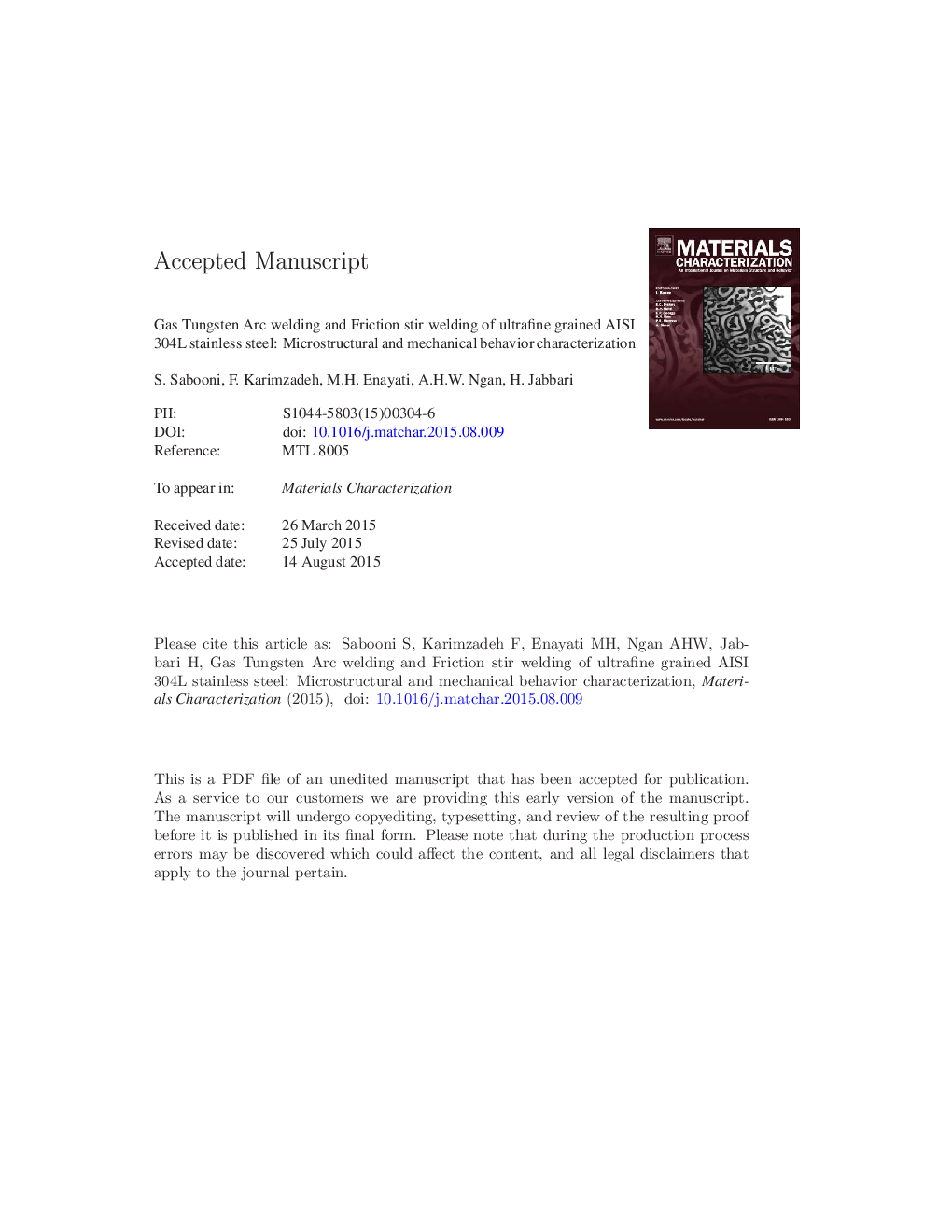| کد مقاله | کد نشریه | سال انتشار | مقاله انگلیسی | نسخه تمام متن |
|---|---|---|---|---|
| 7970013 | 1514378 | 2015 | 53 صفحه PDF | دانلود رایگان |
عنوان انگلیسی مقاله ISI
Gas tungsten arc welding and friction stir welding of ultrafine grained AISI 304L stainless steel: Microstructural and mechanical behavior characterization
دانلود مقاله + سفارش ترجمه
دانلود مقاله ISI انگلیسی
رایگان برای ایرانیان
کلمات کلیدی
موضوعات مرتبط
مهندسی و علوم پایه
مهندسی مواد
دانش مواد (عمومی)
پیش نمایش صفحه اول مقاله

چکیده انگلیسی
In the present study, an ultrafine grained (UFG) AISI 304L stainless steel with the average grain size of 650Â nm was successfully welded by both gas tungsten arc welding (GTAW) and friction stir welding (FSW). GTAW was applied without any filler metal. FSW was also performed at a constant rotational speed of 630Â rpm and different welding speeds from 20 to 80Â mm/min. Microstructural characterization was carried out by High Resolution Scanning Electron Microscopy (HRSEM) with Electron Backscattered Diffraction (EBSD) and Transmission Electron Microscopy (TEM). Nanoindentation, microhardness measurements and tensile tests were also performed to study the mechanical properties of the base metal and weldments. The results showed that the solidification mode in the GTAW welded sample is FA (ferrite-austenite) type with the microstructure consisting of an austenite matrix embedded with lath type and skeletal type ferrite. The nugget zone microstructure in the FSW welded samples consisted of equiaxed dynamically recrystallized austenite grains with some amount of elongated delta ferrite. Sigma phase precipitates were formed in the region ahead the rotating tool during the heating cycle of FSW, which were finally fragmented into nanometric particles and distributed in the weld nugget. Also there is a high possibility that the existing delta ferrite in the microstructure rapidly transforms into sigma phase particles during the short thermal cycle of FSW. These suggest that high strain and deformation during FSW can promote sigma phase formation. The final austenite grain size in the nugget zone was found to decrease with increasing Zener-Hollomon parameter, which was obtained quantitatively by measuring the peak temperature, calculating the strain rate during FSW and exact examination of hot deformation activation energy by considering the actual grain size before the occurrence of dynamic recrystallization. Mechanical properties observations showed that the welding efficiency of the FSW welded sample is around 70%, which is more than 20% higher than the GTAW welded sample.
ناشر
Database: Elsevier - ScienceDirect (ساینس دایرکت)
Journal: Materials Characterization - Volume 109, November 2015, Pages 138-151
Journal: Materials Characterization - Volume 109, November 2015, Pages 138-151
نویسندگان
S. Sabooni, F. Karimzadeh, M.H. Enayati, A.H.W. Ngan, H. Jabbari,